USB 3.0 Flash Drive Roundup
by Zach Throckmorton on July 29, 2011 11:15 AM EST- Posted in
- Storage
- Kingston
- USB 3.0
- Patriot
- Gadgets
- ADATA
- Super Talent
- Flash Drive
- Mushkin
USB 2.0 flash drive performance in a USB 3.0 port
Finally, we tested whether USB 2.0 flash drives benefit from 'up-plugging' into a USB 3.0 port. I expected improved performance compared to use in a USB 2.0 port, and suspected the improvement would be noticeable but not dramatic. Is there any point in plugging USB 2.0 flash drives into USB 3.0 ports?
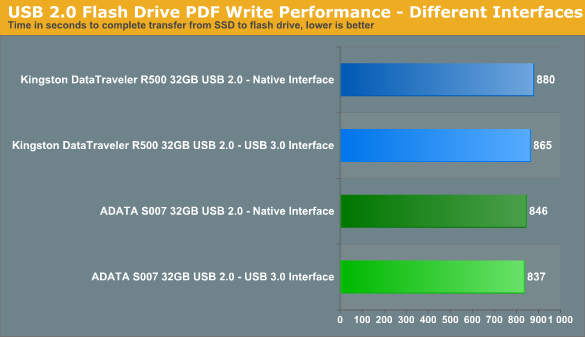
This is likely not even a noticeable difference.
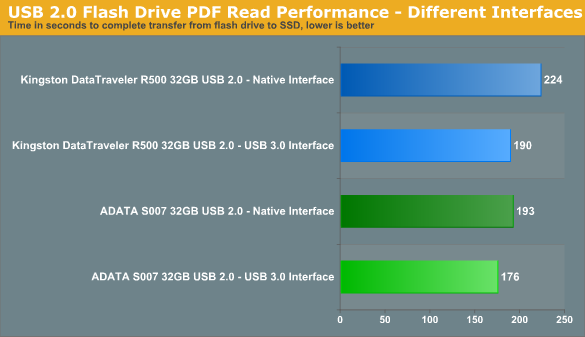
Read differences of small files are likely barely perceptible between the two interfaces.
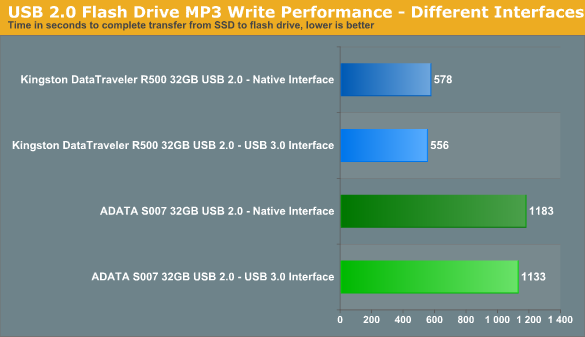
It appears that my suspicion about USB 3.0 giving a performance boost to USB 2.0 drives was correct, though it's not particularly large.
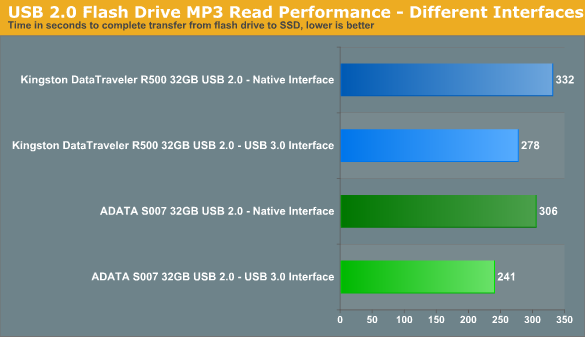
Like the PDF read time differences, the MP3 read time differences are going to be difficult to notice.
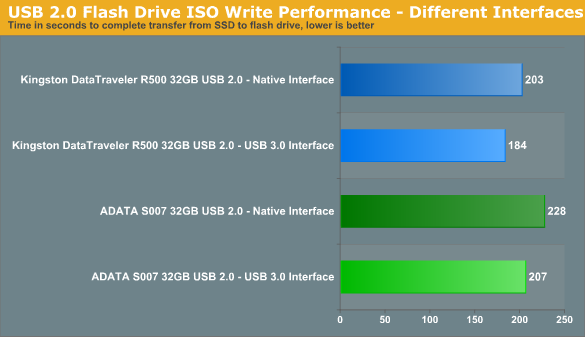
Can you tell the difference between 3 minutes, 23 seconds and 3 minutes, 4 seconds without a stopwatch?
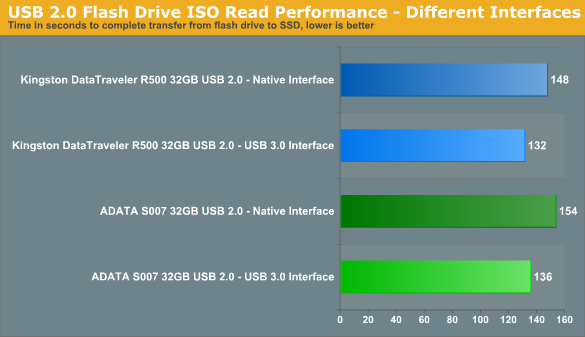
Sometimes every second counts!
The real-world transfer times show that while USB 2.0 flash drives do, in fact, perform faster when 'up-plugged,' this improvement is very minor, to the point of being nearly or not at all perceptible. That said, if you have USB 3.0 ports available, you can shave a few seconds off your transfer times by sticking your USB 2.0 flash drives into them.










42 Comments
View All Comments
webmastir - Friday, July 29, 2011 - link
great write up, thanks!Kelemvor - Friday, July 29, 2011 - link
Absolutely. Hit on all the topics. Thanks. And they really aren't all that much more expensive.sbrown23 - Friday, July 29, 2011 - link
It was good, but I would like to have seen a testing of Linux distro running from the flash drive to get an idea of performance in that type of scenario. Load each up with a Linux distribution, boot each one and run a couple of benchmarks (heck even include boottime, etc.)pvdw - Thursday, December 1, 2011 - link
Definitely. The biggest use I get out of flash drives is for tech support, so I find random reads and writes sorely lacking. :(xygot - Friday, July 29, 2011 - link
This is a nice article for USB 3.0 using flash drive. However, I'm more interested in benchmark between USB 3.0 and eSata using external hard drive. Is there a benchmark on the way?This is what holding me for now if I need to upgrade to USB 3.0 or stay on eSata.
Zenthar - Friday, July 29, 2011 - link
I would like to see that as well. Given the $/GB of those thumbdrives, I would also be curious to see external USB 3.0 SSDs. Different needs will warrant different solutions.For backups for example (mostly sequential read/write), it would probably be more cost/efficient to get an external 2.5 HDD. If you want something to install and run applications from, then perhaps you will get better performance out of an external SSD.
The extra size of external HDD/SSD could be a bit annoying, but this usually translates to lower possibility of losing or washing the drive.
Gigantopithecus - Friday, July 29, 2011 - link
Hi xygot - I don't plan on adding a USB 3.0 vs eSATA performance comparison to the article. However, I can report that using a USB 3.0 HDD dock with a Western Digital WD20EARS on both ends of the transfer, for MP3 files, I get sustained writes of ~30MB/s and sustained reads of 50MB/s. Hope that helps!ckryan - Friday, July 29, 2011 - link
If you want to use a mechanical HDD, just stick with eSata. You won't be limited in any aspect of the HDD's performance. But I think there are some newer eSata and USB3 docks on the way, or possibly already on the market. Why not both?In my eSata II testing, I've found that a 7200rpm desktop drive has almost identical performance in an enclosure as it does with the Sata ports on the MB. As for USB3.0, I have two motherboards that support it, but no usb 3.0 devices. So I can't really speak to 3.0's performance except to say it's not like your HDD will run faster in a USB3 enclosure than it does in your computer.
As for the few USB3 external HDD, it's always been my preference to roll my own with an enclosure and my own HDD.
Sweeo - Saturday, July 30, 2011 - link
Well for me I would go for USB 3,how many comps/other divices got eSata ?USB 3 backword compatable
The thing is "other devises"
doylecc - Monday, August 1, 2011 - link
Adding eSATA is easy if you have a desktop. The adapter is inexpensive; this one costs less than $5 and provides two eSATA ports:http://www.newegg.com/Product/Product.aspx?Item=N8...
The eSata adapter socket mounts on an expansion card bracket that installs in any unused expansion card opening in the back of your computer.
Performance-wise, eSATA will allow you to extract the full performance from any mechanical hard drive. The faster SSDs need SATA III (6GB/sec) or USB 3 bandwidth for full performance.
Of course, if you have a laptop, you're limited to the built-in ports.